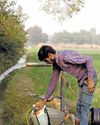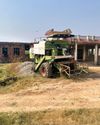
NIRASIYA BAI'S three sons are used to their mother fainting every other week. They keep pieces of shakkar (jaggery) handy and place it swiftly under her tongue, every time she feels dizzy or is on the verge of collapse. In March alone, she fainted thrice. The 52-year-old resident of Shivtarai village in Chattisgarh’s Bilaspur district suffers from diabetes. In 2010, when she was diagnosed with the condition, her blood sugar levels were well beyond the normal range —297 milligrams per decilitre (mg/ dl) in fasting and 361 mg/dl, two hours after food. When Down To Earth (DTE) met Nirasiya in March, her blood sugar levels were under control. But she appeared frail and lacked energy to participate even in the routine agricultural activities she used to do until a few years ago.
DTE visited other families in this village of Gond tribal community, and almost every other household had a similar story to narrate. The situation appears no better in neighbouring villages of Shivtarai in Kota block. Data shared by the district's health office shows that the community health centre (CHC) at Kota has diagnosed 922 new diabetes patients between April 2022 and February 2023. As many as 1,063 people have also been found suffering from hypertension.
What is even more perplexing is that Kota, as informed by Anil Kumar Shriwastawa, chief medical and health officer of Bilaspur, is home to a majority of the district's tribal population, and non-communicable diseases (NCDS) like diabetes have so far been believed to be rare among these communities.
This story is from the {{IssueName}} edition of {{MagazineName}}.
Start your 7-day Magzter GOLD free trial to access thousands of curated premium stories, and 9,000+ magazines and newspapers.
Already a subscriber ? Sign In
This story is from the {{IssueName}} edition of {{MagazineName}}.
Start your 7-day Magzter GOLD free trial to access thousands of curated premium stories, and 9,000+ magazines and newspapers.
Already a subscriber? Sign In

CLIMATE SHAPES SPECIES
Gradual changes in a population that lives in a region with environmental shifts give rise to new species

LEAFY GOODNESS
Leaves of the bottle gourd can be a healthy green addition to the plate

'Story of human origin is still not figured out or over'
Fifty years ago, the discovery of a partial skeleton amid the barren desert landscape of northern Ethiopia transformed our understanding of where humans came from, and how we developed into Homo sapiens. \"Lucy\" was first spotted on November 24, 1974, by the American paleoanthropologist Donald Johanson and his student assistant Tom Gray. Named after the Beatles' Lucy in the Sky with Diamonds, a popular song in the their team's camp at the time, it was immediately clear she was a female, because of her small adult size, and that she had walked upright, unlike chimpanzees. Lucy was also very old-at almost 3.2 million years, she was anointed as the then-earliest known (distant) ancestor of modern humans. Over the following decades, rather fittingly given her name, she became a \"paleo-rock star\", going on a US tour from 2006 following a deal with the Ethiopian authorities.

Deadly discharge
Residents of an industrial cluster blame effluent and sewage treatment plants for discharging poorly treated water that contaminates the area, causes skin diseases

US drug regulator faces Trump heat
FAILED REPUBLICAN presidential candidate Vivek Ramaswamy is making more news now than during his doomed attempt to get the party nomination for president. Ramaswamy's decision to throw in the towel and back Donald Trump after his campaign went nowhere showed acumen, the kind he is famous for in the investment world.

Distorted picture
India's groundwater recovery may be misleading, as new assessment methods inflate annual recharge figures and discontinue on-ground verification

A MAKE OR BREAK YEAR
Expect some stiff targets, radical policy measures and rapid innovations as polycrisis reaches a crescendo this year

Commons in crisis
A landmark 2011 Supreme Court ruling to protect shared resources deepens struggles for India's marginalised communities

Europe faces Russian natural gas supply cuts
UKRAINE'S PRIME Minister Denys Shmyhal said on December 16, 2024, that its gas transit agreement with Russia will expire on January 1, 2025, and will not be renewed. The agreement was to allow transit of natural gas to Europe amid the RussiaUkraine conflict.

Preserving a voice
Non-profit in Madhya Pradesh documents Korku language, makes education accessible for the tribal community